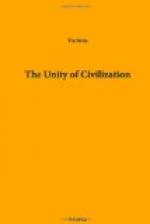it is a synthesis of many different elements.
The Middle Ages had not attained a national economy:
their economy was at the best municipal, and for the
most part only parochial. A national economy has
a higher economic value than a municipal or parochial
economy, because it means the production of a greater
number of utilities at a less cost, and a richer and
fuller life of the mind, with more varied activities
and more intricate connexions. A national economy
could only develop along with—perhaps we
may say it could only develop through—a
national system of politics; and the national State,
which is with us to-day, and with some of whose works
we are discontented, was a necessary condition of
economic progress. With the coming of the national
State the facile internationalism of the Middle Ages
had to disappear; and as economics and politics ran
into national channels, the life of the spirit, hitherto
an international life, suffered the same change, and
national religions, if such a thing be not a contradiction
in terms, were duly born. But a national economy,
a national State, a national Church were all things
unknown to the Middle Ages. Its economy was a
village economy: its mental culture was an international
culture bestowed by a universal Church (a village
culture there could not be, and with a universal Church
the only possible culture was necessarily international);
while, as for its politics, they were something betwixt
and between—sometimes parochial, when a
local feudal lord drew to himself sovereignty; sometimes
national, when a strong king arose in Israel; and
sometimes, under a Charlemagne, almost international.
A consideration of the linguistic factor may help
to throw light on the point in question. Here
again we may trace the same isolation and the same
uniformity which we have also seen in the world of
economics. There was an infinity of dialects,
but a paucity of languages, in the Middle Ages.
One is told that to-day there are dialects in the Bight
of Heligoland and among the Faroes which are peculiar
to a single family. Something of the same sort
must have existed in the Middle Ages. Just as
there were local customs of the manor, the town, and
the fief, there must have been local dialects of villages
and even of hamlets. But here again isolation
was compatible with uniformity. There were perhaps
only two languages of any general vogue in the central
epoch of the Middle Ages, and they were confined by
no national frontiers. First there was Latin,
the language of the Church, and since learning belonged
to the Church, the language of learning. Scholars
used the same language in Oxford and Prague, in Paris
and Bologna; and within the confines of Latin Christianity
scholarship was an undivided unity. Besides Latin
the only other language of any general vogue in the
middle of the Middle Ages was vulgar Latin, or Romance.
To Dante, writing at the close of the thirteenth century,
Romance was still one idioma—even




